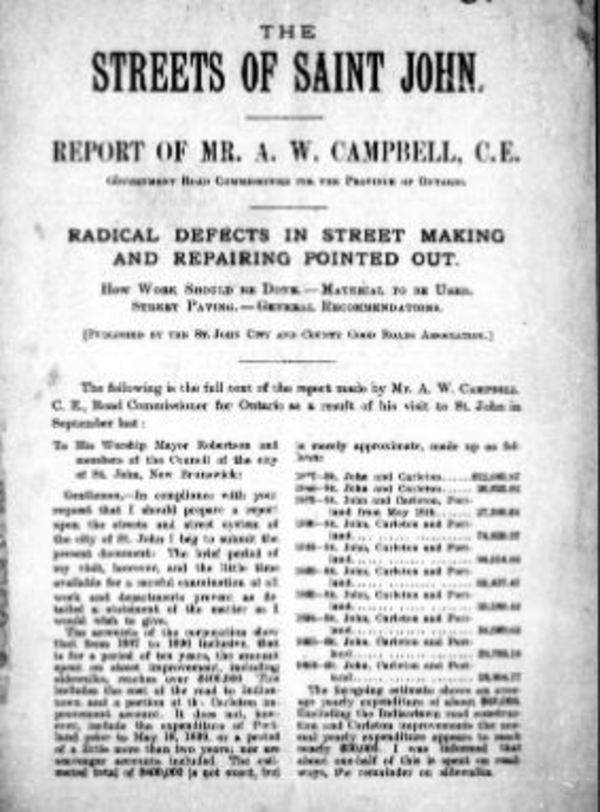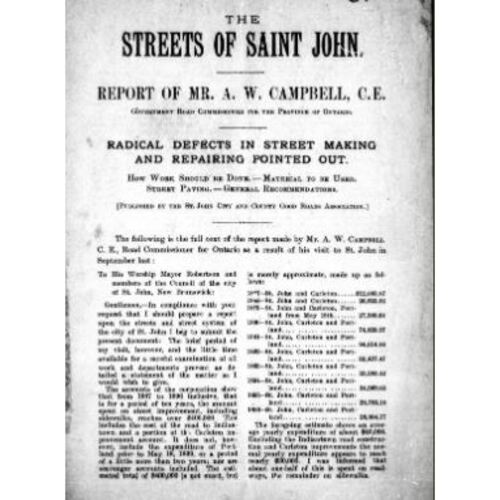
Source: Link
CAMPBELL, ARCHIBALD WILLIAM, surveyor, civil engineer, editor, and civil servant; b. 14 May 1863 in Wardsville, Upper Canada, son of Cameron John Campbell and Elizabeth McLachlan; d. unmarried 9 May 1927 in Ottawa.
Archibald Campbell’s father had immigrated to western Upper Canada from Caithness, Scotland. His mother, also of Scottish background, had been brought up on the family farm in Ekfrid Township; the Campbells moved there from Wardsville in 1864. Archibald received his early education in local schools and graduated from St Thomas High School. He was apprenticed in engineering and surveying for three years to the county engineer for Middlesex and Elgin and under James Anthony Bell, the city engineer in St Thomas. Commissioned a provincial land surveyor in April 1885, he began practice there. In 1888, the year he joined the Canadian Society of Civil Engineers, he formed a private partnership with Bell, specializing in waterworks, drainage systems, and bridges.
In 1891 Campbell succeeded Bell as city engineer and was a founding editor of the monthly Municipal World (St Thomas). He compiled its “Engineering Department” section, which ranged over the responsibilities of municipal engineers, from water and sewer systems to the placement of electricity lines. He was particularly interested in improved roadways and soon became recognized as a progressive advocate. Every aspect of building and managing rural and urban roads was covered in detail. “A good road-bed pays,” he wrote in May 1892. “It saves power, shortens distance and time, increases speed, insures comfort and safety, and is, in whatever way you state it, a good investment.” Public attention to roads had been eclipsed by enthusiasm for railways, but in the 1890s the bicycle craze and the formation of the Ontario Good Roads Association spurred renewed interest. Campbell’s concern was practical: the construction and maintenance of good roads, from the farm gate to the markets and the grain elevators, meant that horses could easily pull greater loads and that transportation costs could be lightened and consumers’ prices lowered. A second factor in his interest was improving the professional status of engineering. Roadwork was the responsibility of municipalities, which usually farmed the tasks out to influential citizens who then employed statute labour. The system was haphazard and standards were shoddy. Campbell used the Municipal World to champion the use of trained engineers. “Good engineering . . . becomes a source of economy instead of an expense to municipal government,” he argued in April 1892. “It is therefore real economy to employ a man thoroughly qualified, and to pay him a liberal salary.”
Campbell’s advocacy, and the convenient fact that he was a Liberal, led to his appointment in April 1896 as provincial instructor in roadmaking, under Minister of Agriculture John Dryden*. In 1900 his position, then styled commissioner of highways, was transferred to Public Works, where he effectively became deputy minister. Through his influence, public dependence on statute labour and toll roads was reduced. In 1902 the beleaguered Liberal government of George William Ross*, seeking re-election, set aside a million dollars to assist counties in highway construction. Campbell stayed in his post when the Conservatives replaced the Liberals at Queen’s Park in 1905. The promotion of high-grade roads was a growing concern for provincial authorities, particularly after motor vehicles began appearing; 178 automobiles were registered in Ontario in 1903 but in 1910 there were 4,230.
By then Campbell’s administrative skills had attracted the attention of the federal minister of railways and canals, George Perry Graham*, who had him appointed as his deputy minister in February 1910. In addition, Campbell assumed the chair of the Canadian Government Railways’ managing board. He thus became the executive officer of one of the largest federal departments, with more than 4,000 employees, including a large, professional engineering corps, among them Ernest Marceau* and Collingwood Schreiber*. Campbell’s annual report for 1912–13 recorded that 8,591 miles of public and private railways were under construction (down some 300 miles from the previous year) and 29,303 were in operation; the aggregate tonnage passing through the canals had risen from 47,587,245 to 52,053,913. The most notable projects underway at this time were the National Transcontinental Railway [see Francis Cochrane*] and the new Welland ship canal. After 1914 Campbell ushered his department through the demands of wartime transportation and nationalizing the Canadian Northern Railway [see Sir William Mackenzie]. In June 1918 he took a leave of absence at full pay to investigate highway improvements for the reconstruction committee of the Union government of Sir Robert Laird Borden*. He resigned as deputy minister in June 1919 and was appointed dominion commissioner of highways.
During his years in Railways and Canals, Campbell had continued his promotion of roads. He attended conferences, gave papers, and was active in both the Canadian Cement and Concrete Association and the good roads committee of the Canadian Society of Civil Engineers. His appointment in 1919 was linked to the passage that year of the Canada Highways Act, which allocated 20 million dollars over 5 years to provide 40 per cent of the cost of constructing or improving roads for a national highway system. The provinces would contribute 60 per cent. All projects had to be approved by both levels of government and had to meet current engineering standards for the type of road (paved or gravel) being built. Campbell and his small staff reviewed all the proposals. The submission and approval of plans took longer than anticipated, so allocation was extended to 1928. This shared-cost program was an important stimulus to highway construction in the 1920s – in 1921 Campbell’s office planned 17,951 miles – but the combined funding was only a tiny portion of what was needed to build a first-class system. In 1922 there were a mere 1,000 miles of paved highways in Canada. Campbell nonetheless travelled extensively to examine roadways, prepared specifications, and worked closely with the provincial departments of highways. In addition, he was a regular delegate at the conventions of the Canadian Good Roads Association, the Ontario Motor League, and the Canadian Automobile Association, where, among other measures, he advocated the abolition of speed limits.
In May 1927 Campbell, who had just returned from a motor tour of the roads between Ottawa, Montreal, and Quebec City, died suddenly in his rooms at the Victoria Chambers on Wellington Street, across from his west block office. The cause was stomach haemorrhaging and cardiac failure. A bachelor, he had devoted his life to his work and his causes – good roads and the professionalization of engineering. During his Ottawa years he developed an international reputation as an expert on highway construction and maintenance and was known throughout North America and Europe as “Good Roads” Campbell. After a memorial service at his Ottawa church, St Andrew’s Presbyterian, Senator George Graham, his former minister, accompanied his body by train to Appin, Ont., for burial in the family plot in Longwoods Cemetery near Melbourne. His small estate, including his shares in Municipal World Limited, went to a brother, a sister, and a niece. Archie Campbell, the St Thomas Times-Journal noted, “was a maker of Canada and his work is the best and most permanent monument to his memory that could be devised.”
Archibald William Campbell’s publications include Road bulletin no.1 ([Toronto, 1896?]), Road bulletin no.2 (Toronto, 1896), and The streets of Saint John: report (Saint John, [1897?]). A summary of his report on Winnipeg streets appears in Reports on Winnipeg pavements, comp. H. N. Ruttan (Winnipeg, 1900). His articles are listed in Science and technology biblio. (Richardson and MacDonald).
AO, F 977-6, Longwoods Cemetery, Caradoc Township, Ont.; RG 22-354, no.13218; RG 80-8-0-1056, no.10042. LAC, RG 32, 425, P.C. 1528, 22 June 1918; P.C. 1021, 15 May 1919. Ottawa Evening Journal, 10 May 1927. Times-Journal (St Thomas, Ont.), 10 May 1927. Assoc. of Ontario Land Surveyors, Annual report (Toronto), 1928: 114-16. Can., House of Commons, Debates, 1919; Parl., Sessional papers, 1918, no.30: 427; 1921, no.20: 83-84. Canada Gazette, 5 Feb. 1910: 2301. Canadian annual rev., 1905-1925/26. Canadian men and women of the time (Morgan; 1898 and 1912). E. C. Guillet, The story of Canadian roads (Toronto, 1966). Municipal World (St Thomas), April 1892: 41; May 1892: 53. Ont., Legislature, Sessional papers, 1897, no.24; 1901, no.27; 1906, no.27. Statistics Canada, Historical statistics of Canada, ed. F. H. Leacy (2nd ed., Ottawa, 1983; also available online at Statistics Canada’s website, www.statcan.ca), ser.T147, T171. Who’s who in Canada, 1925/26.
Cite This Article
Robert Craig Brown, “CAMPBELL, ARCHIBALD WILLIAM,” in Dictionary of Canadian Biography, vol. 15, University of Toronto/Université Laval, 2003–, accessed December 12, 2025, https://www.biographi.ca/en/bio/campbell_archibald_william_15E.html.
The citation above shows the format for footnotes and endnotes according to the Chicago manual of style (16th edition). Information to be used in other citation formats:
| Permalink: | https://www.biographi.ca/en/bio/campbell_archibald_william_15E.html |
| Author of Article: | Robert Craig Brown |
| Title of Article: | CAMPBELL, ARCHIBALD WILLIAM |
| Publication Name: | Dictionary of Canadian Biography, vol. 15 |
| Publisher: | University of Toronto/Université Laval |
| Year of publication: | 2005 |
| Year of revision: | 2013 |
| Access Date: | December 12, 2025 |



